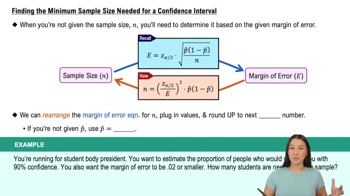Table of contents
- 1. Intro to Stats and Collecting Data55m
- 2. Describing Data with Tables and Graphs1h 55m
- 3. Describing Data Numerically1h 45m
- 4. Probability2h 16m
- 5. Binomial Distribution & Discrete Random Variables2h 33m
- 6. Normal Distribution and Continuous Random Variables1h 38m
- 7. Sampling Distributions & Confidence Intervals: Mean1h 3m
- 8. Sampling Distributions & Confidence Intervals: Proportion1h 12m
- 9. Hypothesis Testing for One Sample1h 1m
- 10. Hypothesis Testing for Two Samples2h 8m
- 11. Correlation48m
- 12. Regression1h 4m
- 13. Chi-Square Tests & Goodness of Fit1h 20m
- 14. ANOVA1h 0m
8. Sampling Distributions & Confidence Intervals: Proportion
Confidence Intervals for Population Proportion
Problem 6.R.4b
Textbook Question
Arm Circumferences Arm circumferences of adult men are normally distributed with a mean of 33.64 cm and a standard deviation of 4.14 cm (based on Data Set 1 āBody Dataā in Appendix B). A sample of 25 men is randomly selected and the mean of the arm circumferences is obtained.
b. What is the mean of all such sample means?
 Verified step by step guidance
Verified step by step guidance1
Identify the key information provided in the problem: the population mean (Ī¼ = 33.64 cm), the population standard deviation (Ļ = 4.14 cm), and the sample size (n = 25).
Recall the property of the sampling distribution of the sample mean: the mean of the sampling distribution of the sample mean is equal to the population mean (Ī¼).
State the formula for the mean of the sampling distribution of the sample mean: Ī¼_xĢ = Ī¼, where Ī¼_xĢ is the mean of the sample means and Ī¼ is the population mean.
Substitute the given population mean (Ī¼ = 33.64 cm) into the formula to determine the mean of the sample means.
Conclude that the mean of all such sample means is equal to the population mean, which is 33.64 cm.
 Verified video answer for a similar problem:
Verified video answer for a similar problem:This video solution was recommended by our tutors as helpful for the problem above
Video duration:
1mPlay a video:
Was this helpful?
Key Concepts
Here are the essential concepts you must grasp in order to answer the question correctly.
Sampling Distribution of the Sample Mean
The sampling distribution of the sample mean refers to the distribution of means obtained from all possible samples of a specific size drawn from a population. According to the Central Limit Theorem, this distribution will be approximately normal if the sample size is sufficiently large, regardless of the population's distribution. The mean of this sampling distribution equals the population mean.
Recommended video:

Sampling Distribution of Sample Proportion
Central Limit Theorem
The Central Limit Theorem (CLT) states that the distribution of the sample means will approach a normal distribution as the sample size increases, typically n ā„ 30 is considered sufficient. This theorem is crucial for making inferences about population parameters based on sample statistics, as it allows for the application of normal probability methods even when the original population distribution is not normal.
Recommended video:
Guided course

Calculating the Mean
Mean of Sample Means
The mean of all sample means, also known as the expected value of the sample mean, is equal to the population mean. In this case, since the population mean of arm circumferences is given as 33.64 cm, the mean of all sample means for samples of size 25 will also be 33.64 cm. This concept is fundamental in inferential statistics, as it underpins the reliability of sample estimates.
Recommended video:
Guided course

Calculating the Mean

 5:45m
5:45mWatch next
Master Constructing Confidence Intervals for Proportions with a bite sized video explanation from Patrick
Start learningRelated Videos
Related Practice






